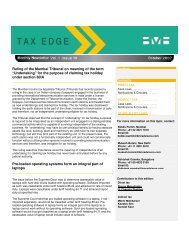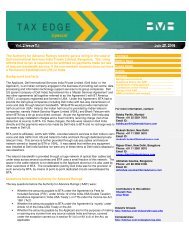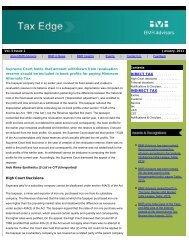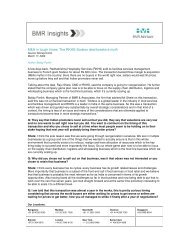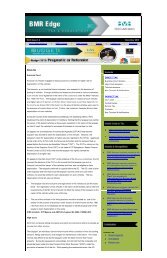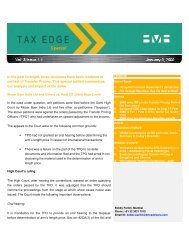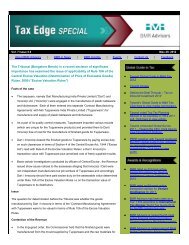Corporate Tax 2010 - BMR Advisors
Corporate Tax 2010 - BMR Advisors
Corporate Tax 2010 - BMR Advisors
Create successful ePaper yourself
Turn your PDF publications into a flip-book with our unique Google optimized e-Paper software.
Aivar Pilv Law Office<br />
Estonia<br />
3.2 Would there be any withholding tax on royalties paid by a<br />
local company to a non-resident<br />
According to the Income <strong>Tax</strong> Act, 10% withholding tax applies to<br />
royalties paid to non-resident persons. Royalty payments to<br />
qualifying EU companies my be exempt if they meet the conditions<br />
for the Concil Directive 2003/49/EC of 3 June 2003. The<br />
withholding tax exemption will not apply to any part of the royalty<br />
that exceeds the value of similar transactions carried out between<br />
unrelated persons.<br />
if the value of the transaction conducted with the associated person<br />
had been such as applied by non-associated independent persons<br />
under similar conditions.<br />
For implementation of transfer pricing rules, a resident company is<br />
required to submit additional information on the transactions with<br />
associated persons, activity of companies belonging to the same<br />
group and structure of the group at the demand of a tax authority.<br />
The methods for determining the value of transactions are<br />
established by a regulation of the Minister of Finance.<br />
Estonia<br />
3.3 Would there be any withholding tax on interest paid by a<br />
local company to a non-resident<br />
Income tax is withheld from interest payment subject to income tax<br />
paid to a non-resident or to a resident natural person.<br />
Income tax is charged on interest received by a non-resident from<br />
the Estonian State, a local government or a resident, or from nonresident<br />
through or on account of its permanent establishment in<br />
Estonia, if it significantly exceeds the amount of interest payable on<br />
the similar debt obligation under the market conditions during the<br />
period when the debt obligation and payment of the interest<br />
occurred. In that case, income tax is charged on the difference<br />
between the interest received and the interest payable according to<br />
market conditions on the similar debt obligations.<br />
3.4 Would relief for interest so paid be restricted by reference<br />
to “thin capitalisation” rules<br />
There are no “thin capitalisation” rules in Estonia.<br />
3.5 If so, is there a “safe harbour” by reference to which tax<br />
relief is assured<br />
There is no “safe harbour” principle in the laws.<br />
3.6 Would any such “thin capitalisation” rules extend to debt<br />
advanced by a third party but guaranteed by a parent<br />
company<br />
See the answer above (question 3.4).<br />
3.7 Are there any restrictions on tax relief for interest<br />
payments by a local company to a non-resident in addition<br />
to any thin capitalisation rules mentioned in questions<br />
3.4-3.6 above<br />
4 <strong>Tax</strong> on Business Operations: General<br />
4.1 What is the headline rate of tax on corporate profits<br />
The system of corporate earnings taxation in force currently in<br />
Estonia is a unique system, which shifts the moment of corporate<br />
taxation from the moment of earning the profits to the moment of<br />
their distribution.<br />
Until 31 December 2008, payments upon proceeds from<br />
liquidations, payments upon capital reductions and redemption or<br />
return of participation in a company were treated as capital gains of<br />
the natural person or non-resident recipient and shareholder. From<br />
1 January 2009, these payments will generally be subject to<br />
corporate income tax in the hands of the payer: an Estonian<br />
company at the moment of distribution.<br />
The implicit way to distribute profits is to do that through fringe<br />
benefits, gifts and donations, as well as expenditures and payments<br />
unrelated to business activity.<br />
All of these profit distributions are taxed at a rate of 21/79 (or<br />
slightly over 26.6%). This tax rate should not be deceiving. It is<br />
still the same rate of 21% as in the provisions for the taxation of<br />
salaried work payments. The difference is that 21% is applied to<br />
gross payments and 21/79 is applied to net payments.<br />
The resident legal person and the non-resident legal person acting<br />
through its permanent establishment registered in Estonia carrying<br />
out profit distribution has to pay 21/79 of the amount of profits<br />
distributed.<br />
From 1 January 2009, income tax rate on:<br />
payments to a non-resident for services provided in Estonia;<br />
royalties; and<br />
payments made to a non-resident artiste, sportsman or<br />
sportswoman for activities conducted in Estonia,<br />
is 10%, unless a bilateral tax treaty between Estonia and the treaty<br />
partner specifies for a lower rate or exemption.<br />
See the answers above (questions 3.4-3.6).<br />
4.2 When is that tax generally payable<br />
3.8 Does Estonia have transfer pricing rules<br />
As of 1 January 2007, amendments to the Income <strong>Tax</strong> Act became<br />
applicable which expand the possibilities for taxation of transfer<br />
prices.<br />
If the value of a transaction conducted between a resident legal<br />
person and a person associated with the resident legal person differs<br />
from the value of similar transactions conducted between nonassociated<br />
persons, the tax administrator may, upon determining the<br />
income tax, use the values of transactions applied by non-associated<br />
independent persons under similar conditions. In that case, income<br />
tax is charged either on the income which the taxpayer would have<br />
derived or the expense which the taxpayer would not have incurred<br />
ICLG TO: CORPORATE TAX <strong>2010</strong><br />
© Published and reproduced with kind permission by Global Legal Group Ltd, London<br />
Given the nature of the distribution tax, the relevant taxable period<br />
is the calendar month. The tax is payable by the 10th day of the<br />
month following the taxation period, i.e. the calendar month when<br />
the profits were distributed.<br />
4.3 What is the tax base for that tax (profits pursuant to<br />
commercial accounts subject to adjustments; other tax<br />
base)<br />
The tax base is the corporate income tax levied on:<br />
corporate profits distributed in the tax period; and<br />
taxable gifts, donations and representation costs, expenses<br />
and payments unrelated to business.<br />
WWW.ICLG.CO.UK 87







